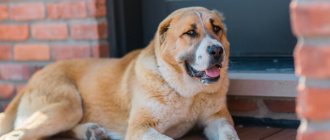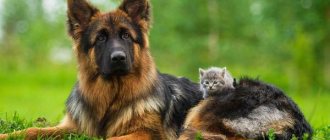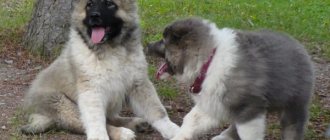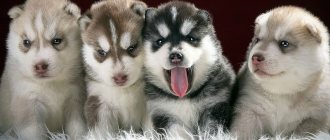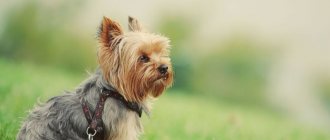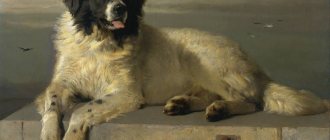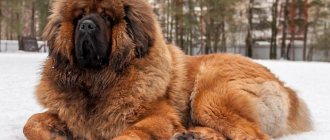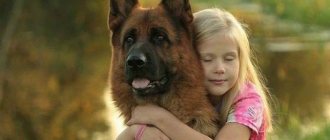Representatives of the breed are characterized by the following features:
- categorical perception of the world, Caucasians divide the entire environment into two parts: “their own” and “theirs”;
- balanced behavior - four-legged guards are able to distinguish between real and imaginary danger;
- the ability to be “on alert” at any time of the day - they hear extraneous sounds even during sleep;
- instant reaction to a trespasser on their property - even if it is a neighbor entering the yard;
- clear distribution of hierarchical influence - the owner is the main authority for them, the attitude towards other family members is friendly;
- representative appearance - Caucasians have a soulful, intelligent look and the terrifying exterior of a wolfhound;
- the need for socialization and firm upbringing - without this, puppies will grow up uncontrollable, and with such a size this is simply dangerous;
- complete and final maturation - adult individuals, unlike representatives of many other breeds, do not retain any elements of childish behavior or puppyish qualities;
- unpretentiousness to living conditions - they are not afraid of either cold or heat;
- fairly good health - activity remains almost throughout life.
Fans of the breed note that the Caucasian Shepherd is infinitely devoted to its owner and his family. This is a strong and thinking dog with excellent guarding qualities. It is difficult to find a watchman as reliable as a Caucasian. But a pet is taught to be obedient from childhood. Otherwise, even ordinary hygiene procedures, such as brushing or examining teeth, will become a problem.
Origin history and interesting facts
The history of the breed goes back over two thousand years. The Urartu-Ararat kingdom is considered the homeland of Caucasian dogs. It was there that wolfhounds helped herders herd sheep. Over time, the breed spread throughout the Caucasus and surrounding areas.
White Caucasian Shepherd
For your information! These animals began to be imported to Russia during the Caucasian War. Wolfhounds were considered living trophies of officers participating in hostilities. Unfortunately, the Russian nobility was not particularly eager to breed shepherd dogs.
They began to engage in serious breeding activities only in the 30s. XX century
During World War II, the USSR lost almost the entire gene pool of Caucasian Shepherd dogs. The breed was restored only in the 70s. Around this time, shaggy “highlanders” began to be bred and actively purchased.
Advantages and disadvantages
The advantages include a well-groomed appearance and a familiar appearance.
There are significantly more downsides to it. These dogs are among the breeds that may experience behavioral disturbances after experiencing pain. Ears also play an important role in the animal’s communication with both humans and its fellow animals. For example, if a dog raises its ears, it means it senses danger, and if it tightens its ears, it means it obeys. Removal deprives her of the opportunity to express her emotions and fully communicate.
Standard and description of the Caucasian Shepherd breed
Irish Wolfhound: characteristics of the breed
Today the description of the Caucasian Shepherd breed standard is as follows:
- head with a wide skull, convex forehead and short muzzle;
- the ears are small and set high;
- the eyes are slanting, oval-shaped, deep-set;
- regular scissor bite;
- large body;
- the neck is short and strong;
- the sternum is wide;
- stomach tucked in;
- oval-shaped and large paws;
- fluffy tail;
- The fur is thick and rough to the touch. According to the type of coat, the Caucasian wolfhound can be short-haired (5-7 cm) and long-haired (10-12 cm).
Note! The short-haired Caucasian Shepherd is shaped like an Alabai. For this reason, they are often confused.
These dogs weigh from 50 to 70 kg. They reach a height of 65-70 cm.
Color variations
Animals of the following colors are subject to the Caucasian Shepherd breed standard:
- white;
- all shades of gray;
- different variations of brindle;
- redhead.
Red Caucasian Shepherd Dog
Appearance of puppies
A Caucasian Shepherd puppy resembles a small bear cub: plump, round and thick-footed. However, already from childhood, the little wolfhound is characterized by a concentrated and observant gaze, characteristic of adults.
Caucasian Shepherd puppies
Main colors of Caucasian Shepherd dogs
Caucasian Shepherds differ from most dogs of other breeds in a wide variety of colors: dark gray, piebald, brindle, zoned gray, spotted, white, fawn, brown, in combination with all the listed colors. The color of the undercoat of dogs of any color, in contrast to the main guard hairs, is always lighter in color.
The formation of the breed took place in the steppe and mountainous regions of the Caucasus, and the main purpose of the breed was to protect a flock of sheep from predators. There are known cases when, in night fights with wolves, shepherds, mistaking a dog for a wolf, accidentally shot their guards. Based on this, shepherds began to breed dogs of red, brown, brindle, white or any light colors, which made it possible to easily distinguish their dog from wolves.
Among herding dogs, white was the dominant color, but since the 60s, due to the growing popularity of the breed, dogs of various colors began to appear, but Caucasians with a pure white color have become a rarity. Each of the colors listed above is available in a wide variety of color combinations. For example, brown color can be almost black or red-red, red - from rusty-red with a dark coating to light red with a cream tint. Gray – from dark, almost black to light fawn-gray. Brindle coloring can have different color intensities and the number of “tiger spots”. Caucasians look impressive in black and white, with the main color being black and mint white on the chest, sides, back, tips of the paws and tail.
Dogs with a dark mask, black nose, dark lip lining and bright coat color are considered more preferable and attractive. Poorly pigmented dogs with a faded coat color, light eyes and a weakly defined mask are not very popular among breeders of this unique breed. Light eye color, brown nose and lip rims in Caucasians are allowed with a zone-brown coloring of the guard coat. With solid colors, Caucasians should have a dark mask on the muzzle, dark eyes, black rims on the lips, eyelids and nose, as well as large white spots on the neck, chest, tip of the tail and paws. The monochromatic color that determines the suit is called the primary color - white, black, red. The fawn color is represented by a light red color with a characteristic cream, golden or red tint at the end of the guard hair. Zonal gray resembles the color of a wolf.
Wool length
Caucasian Shepherds have long, thick hair and a soft, dense undercoat that protects the dog from severe frosts. Based on the length of their coat, Caucasians are conventionally classified into three groups:
- Long-haired. The guard hair is long over the entire surface of the dog's body, with well-developed decorative hair, which forms a lush “collar”, mane, “pants”, and a thick, fluffy tail. At the same time, the decorating hair forms, as it were, a second mane on the dog’s croup, visually lifting it.
- Short-haired. The guard coat is short and lies close to the body. On the neck the hair is longer and thicker, the “pants” and tail are medium fluffy. Representatives of short-haired breeds are distinguished by more pronounced, prominent muscles and an athletic build.
- Intermediate, combined type. This variety is characterized by an average length of guard hair that does not fit tightly to the body. Dogs of this type have a similar appearance to bears, with a prominent mane, feathering, “breasts” and tail.
Main types of Caucasian Shepherd dogs
Considering the wide distribution of the breed and the fact that Caucasians are one of the most ancient breeds, the dogs acquired characteristic external differences and several main intra-breed types were identified.
Mountain type. The dogs have well-developed bones, long, heavy hair, a massive head, a highly developed chest, and an elongated body. The largest representatives are Caucasians, bred in the Georgian region. Most representatives have a uniform color. Caucasians, bred in the Azerbaijani region, have a light or red coloration and a darker mask on the face.
Steppe type. Dogs living in warm regions with a dry and hot climate needed endurance, since when driving sheep, they rarely encountered ponds or sources of water along the way. The constitution of the dogs is strong, the head is correctly shaped, the chest is well developed, and the legs are strong. The color is predominantly light, fawn or brindle.
Armenian type.
Representatives of this type are in many ways similar to Caucasians of the Georgian type, but are smaller in size and have weaker bones. The coat is long, thick, brown in color, with large light spots, plain with a white collar or brindle. The constitution is strong, the muzzle is elongated, the temperament is balanced. Dogs of the Garbanian type have a strong constitution, an athletic build, the correct taste, and a wide variety of colors. The dogs have excellent guarding qualities and are distinguished by their aggressiveness. The Aboriginal Caucasian Shepherd Dog. This type was formed spontaneously, so dogs have increased endurance to any climatic conditions. Caucasians of this type are quite freedom-loving and willful, less attached to their owner, but very trainable. Animals have well-developed muscles, bones, a round chest, a wide back, and a high croup.
Popular types
East European Shepherd: characteristics of the breed
In addition to the officially established breed standard, there are many intrabreed species of Caucasian Shepherd in the Caucasus. The Dagestan and Azerbaijani species are especially common.
Dagestan view
Dagestan wolfhounds are more roughly coordinated. Their skeleton is much stronger. They are predominantly shorthaired with spotted or brindle patterns.
Azerbaijani view
Azerbaijani Shepherds are divided into three subspecies.
- mountain aboriginal dogs with a coat length of up to 13 cm;
- intermediate subspecies - ideal helpers for shepherds;
- steppe dogs, otherwise called the Azerbaijani aboriginal dog, or lowland subspecies - short-haired individuals.
There are also other types of Caucasian guard dogs.
- Georgian - larger animals with an elongated body;
- Kazbek - spotted shepherd dogs of rough build;
- Garbani - animals with increased aggressiveness and a shortened muzzle;
- Gergeti - massive dogs with a longer muzzle;
- Chechen smooth-haired shepherd dogs;
- Akhaltsikhe - the fruit of selection of Gargan and Kazbek species with Gergeti;
- Armenian - long-haired dogs in brown or gray color variations;
- Ingush and Ossetian - today these species are officially recognized as extinct.
Caucasian Shepherd in our time
The Caucasian Shepherd is a giant breed weighing between 45 and 100 kilograms and a height of 65 to 75 centimeters.
This is a fearsome, muscular and powerful looking breed, there are several types, some of which can be even larger and stronger, and some that can lean towards massive and strong bones.
This difference is often observed between dogs in mountainous areas and dogs in lowland areas. The coat is also different, with the latter having a shorter coat and the former having a longer and thicker coat.
Wool is weather resistant, and when it is younger, the fur becomes thinner. Colors can range from grey, brindle, pied, fawn, brown and white, brown is not allowed for FCI show dogs.
This dog has a tail covered with long, fluffy hair, and hips that are slightly raised from the topline. His front legs are straight and long, and his hind legs are powerful.
Its paws are heavy, very large and have protection from the cold in the form of fur between the toes. His eyes are somewhat deep-set and dark. The nose is large, with wide open nostrils, black. In some areas of its native region the ears are short. They are also well covered with fur to protect them from the cold.
Disqualifying faults
Belgian Shepherd Malinois: description of the breed, character
Competition or exhibition officials may disqualify a representative of the Caucasian dog breed if he is found to have the following developmental features that contradict the norms of the official standard:
- dwarfism;
- various variations of black, tan and blue colors;
- malocclusion;
- gray, blue or brownish tone in the area around the eyes, nose and lips;
- docked tail;
- the presence of not all teeth;
- turning of the eyelids;
- absence of testes in the scrotum.
Important! Caucasian Shepherd mixes cannot be bred as they are disqualifying faults.
Caucasian guard shepherd breed characteristics
Before getting a pet, you should carefully read everything about the breed. Recently, North Caucasian Shepherd Dogs have become quite popular. Many owners of country houses would like to have these excellent security guards in their yard. But sometimes they are afraid to get such a dog. There is an opinion that animals are too aggressive, angry and difficult to train.
Experts and breeders say that these are completely incorrect and biased conclusions. If you raise a shepherd dog correctly, paying maximum attention to it, then as a result you can get the most devoted and loving friend. A balanced and calm guard.
If initially dogs were used as protectors of sheep flocks, now they are quite effectively bred for guarding activities. The main task of Caucasian Shepherd Dogs is to protect private or industrial areas from intruders. These are excellent watchmen. They are suspicious, hostile and have a very menacing appearance, a very intimidating description of the breed.
The character of the Caucasian Shepherd is strong and independent, requiring a special approach. Not every owner can find a common language with his grown pet, much less keep this large and strong animal. But if the dog has recognized the leadership of the owner, a more devoted defender cannot be found.
When a puppy appears in a family, it chooses its owner and singles him out with especially gentle signs of attention. When a four-legged friend grows up in a peaceful, friendly environment, becoming an adult dog she will treat all family members with love and affection. An intelligent, receptive animal will bring only joy and positivity to your home.
Features of character and behavior
"Caucasians" are dogs with a balanced character. They are not aggressive towards people. Wolfhounds are so devoted to their owner that they will get bored even if they are separated for a short time.
Shepherds are natural guards. These purebred dogs have been used for thousands of years to protect sheep flocks from various predators, and private homes from strangers.
“Caucasians” are endowed with analytical thinking. They are able to calculate their next actions.
Wolfhounds are against all fuss. They like to be in a calm environment. In this way, animals save energy for cases when the owner or the herd is in danger from the outside and the pet’s protective skills are required.
Note! “Caucasians” were allowed to full-time service from the age of six months. A 6-month-old shepherd dog is already able to cope with any predator.
Attitude towards other family members, children and pets
Despite the fact that the “Caucasian” is a dog that is always loyal to only one owner, it is tolerant of other family members. Children and pets are no exception; the wolfhound will always protect them from strangers. A dog with remarkable strength will never direct its aggression against other members of the household if the owner from childhood designates the place of the shaggy “highlander” in his family.
Note! In order to make friends with a dog, all their joint games must initially be carried out in the presence of an adult, who is obliged to teach his child how to properly treat his four-legged friend.
Attitude towards strangers and other animals
If strangers or animals enter the territory of a private house or other object guarded by a wolfhound, the shepherd's behavior towards newcomers will depend on whether the owner is nearby. The owner can give the pet a sign that the guest does not pose a threat. In this case, the dog's behavior will be loyal. In the absence of the owner, the shepherd will always show aggression in response to attempts by strangers to enter the territory entrusted to it.
Character
The main character traits are courage and determination, devotion and independence. These are the best dogs for home protection: they will not bark in vain, they control the territory entrusted to them with their eyes. Caucasians are distinguished by stubbornness and perseverance, but with proper upbringing they are flexible and obedient. Caucasian Shepherd and children get along great. Dogs tolerate the pranks of children condescendingly and do not offend them in the same way as other pets. However, they should not be left unattended with children.
There is an opinion that the Caucasian Shepherd is an angry dog. She is even included in the top 10 most aggressive dogs in the world. But this only applies to improperly raised animals. In fact, behind the threatening appearance lies a kind heart that knows how to serve faithfully. The Caucasian is called a one-owner dog due to the fact that it is very painful to change owners. Having become attached to the owner and his family, she will protect them from any danger.
The main purpose of the breed is to protect people, homes, and herds of animals. Experienced, trained wolfhounds successfully replace shepherds. In case of danger, they do not leave the herd, walk around and scare away predators. If necessary, they can go against a wolf and even a bear.
Externally, a Caucasian looks like an Alabai. The Caucasian Shepherd and Alabai differ in temperament. Alabai, although larger, is softer and more flexible than his fellow Caucasian, who has an explosive and freedom-loving character.
Grooming
The fur of wolfhounds is thick and tough, requiring careful grooming.
“Caucasian” puppies begin to be bathed at six months of age. They do this approximately once a month.
To avoid the formation of tangles, the shepherd's coat will need to be combed with special brushes for dogs every 2-3 days, and even daily during shedding.
Your pet will need to be trimmed once every 2 months. There are grooming salons for these purposes.
In addition to haircuts, grooming salons provide other various services:
- water procedures;
- ear cleaning;
- nail trimming;
- consultations with a zoopsychologist.
Features of maintenance and care
The impressive size of shepherd dogs requires them to be kept in enclosures. Caucasians are undemanding in care, but keeping such a dog requires certain knowledge:
- The dog's fur gets dirty while walking, so it needs to be bathed 1-2 times a month. To prevent the formation of tangles in the fur in the axillary area, in the groin and in the area of the hock joints, the coat is lubricated with cosmetic oil. You can dry the cover with a towel or hairdryer without using a hot jet. Comb it carefully with a special comb so as not to make the dog angry due to pain or discomfort.
- We must not forget about eye hygiene. Some dogs experience inflammation due to loose eyelids.
- The ears should also be checked regularly as dirt and wax accumulate in them. It is recommended to treat your dog with a tick repellent once a month. They apply it so that she cannot lick it off.
- The puppy's ears must be cropped within the first three days of life. This is done by an experienced veterinarian. If surgery is delayed until a later date, your pet will lose more blood and the healing process will be slow. Therefore, if a dog did not undergo this operation as a puppy, it is left with undocked ears. Ear cropping is an important procedure. In a fight with wolves and other enemies, long ears will be the main target; damage to them will lead to large loss of blood.
- Your pet's mouth needs hygiene; bone fragments, splinters may get stuck in it, or caries may appear. Use a special brush and powder to clean your teeth from plaque at least once a week.
- The dog's paws are examined after each walk. In winter, they must be thoroughly cleaned of reagents. Nails should be trimmed once a month.
- It is imperative to walk your pet for 1-1.5 hours a day. From the age of two months, a leash is put on while walking. You can shoot it in quiet and deserted places.
- To maintain professional form, 2-3 days a week are devoted to consolidating the learned skills.
- It is forbidden to keep a dog on a leash in a dark room.
- The pet should have its own resting place both in the apartment and on the street.
With proper care, dogs live as full a life as possible for as long as possible. Puberty in the Caucasian Shepherd occurs at the age of 1 year and 5 months, but it is recommended to breed dogs closer to 2 years. Mating should take place on the dog’s territory, so he will feel calmer.
What to feed your dog and puppy
A Caucasian's diet should be complete, just like any dog's. Dog handlers practice feeding once a day for adult dogs and twice a day for young animals. The basis of nutrition is meat and offal. The nutritional norm for two-month-old puppies is 300-350 g per day. Further, the norm increases and by 1 year it is equal to 1 kg per day. Meat can be served raw, but offal should be boiled before serving. The young shepherd's diet also includes porridge with water or broth, vegetables and herbs, boiled eggs, and fermented milk products. An adult dog can be given pasta and sea fish without bones.
Prohibited foods for the Caucasian Shepherd are chicken bones, lard and pork, smoked and salted products, legumes, cabbage and potatoes.
If you plan to feed your dog with ready-made store-bought food, it must be premium. It contains all the necessary nutrients.
How to train a Caucasian
Caucasian Shepherd puppies do not cause any trouble in the first months; they are calm, playful, and look like little bear cubs. But over time they begin to show their character. Training must begin after the puppies are 3 months old. What is learned at this age remains in the dog’s head forever. Training is always carried out by one person - the owner.
The first commands for a puppy should be: near, impossible, ugh and place. At the age of 3 months, puppies already understand these commands and respond to nicknames. Also, one of the first habits of the dog is to make the correct reaction to wearing a muzzle.
To earn the dog's trust, you must show yourself to be a strict but fair owner. Under no circumstances should you shout at or scold the dog. This will cause retaliatory anger. Any manifestation of aggression towards household members must be strictly suppressed. The dog must firmly understand what it can and cannot do.
When keeping in an apartment, you need to teach your pet to react correctly to strangers. The dog is usually distrustful and does not make contact with strangers, but behaves kindly around its owner. You should not try to teach your dog to carry out many commands at once. Let him work on one first and then move on to the next. Dog breeders note that these shepherd dogs especially enjoy fetching. The shepherd dog can be slow in following commands, in this case you should not rush it.
It is important to immediately stop eating garbage from the ground, biting hands, and jumping on the owner’s chest. Otherwise, as the dog grows up, it will behave the same way. The Caucasian is smart; if he does not show strength, he will be able to take advantage of the owner’s weakness. After completing the command, you need to praise the pet and treat it with something tasty. As long as a shepherd lives, it needs to be trained so that it is safe for others. Raising an obedient and trained dog requires patience and strength of character, but the result can be a sensitive, reliable and loyal family member.
Oral care
Healthy teeth are the pride of a wolfhound, so they also require proper care. Therefore, it is necessary to periodically examine your pet’s oral cavity.
When his baby teeth fall out, you should make sure that their roots are completely reabsorbed. Otherwise, they will need to be removed for the subsequent proper growth of permanent teeth.
To avoid the development of tartar, you need to exclude sweets from your four-legged friend’s diet. You will also have to regularly brush your shepherd's teeth with a special toothpaste.
Important! If you have gum disease or caries, you should immediately contact a veterinarian.
History of the origin of Caucasian Shepherds
The Caucasian Shepherd is an ancient breed of dog, the origin of which has no clear history. Of course, the dog originates from the Caucasus Mountains. People needed watchdogs that could independently guard their flocks of sheep while the shepherd was away. A person needed an independent, self-sufficient and intelligent dog that knows its territory, can quickly make decisions and process information.
There is a version that the Caucasian Shepherd was obtained by crossing dogs with wolves. This well explains the dog’s freedom-loving disposition, its independence and aggressive character. Also, wolves, like Caucasian Shepherd Dogs, are purely territorial animals that protect their borders well. But this is only one version of the origin of this breed.
The second version is that Caucasian Shepherd Dogs originate from the Tibetan Great Dane breed - these dogs are considered by some to be the ancestors of all dog breeds in the world. Caucasian Shepherd Dogs are very similar to Tibetan Great Danes, so at least crossing with them is a completely possible circumstance.
Interesting fact: Caucasian Shepherd Dogs became widespread in Russia, but it is impossible to say at what time. In the USSR, they were widely used as service dogs back in the 20s.
The dogs were recognized as the best guard dogs and were also used in fierce dog fights. Caucasian Shepherd dogs are still slowly penetrating into Europe. Only recently have Western cynological associations become interested in these dogs.
Ear cropping
Caucasian Shepherd puppies have their ears cropped on the second or third day after birth. This is done in many domestic nurseries, although this surgical procedure is not mandatory.
In past centuries, wolfhound breeders cropped the ears of all small puppies. This was done in order to protect shepherd dogs from blood loss, since the larger the pet’s ears, the more likely it is to injure them during a fight.
Important! It is unacceptable to try to crop dog ears at home. This operation is performed only in a veterinary clinic or nursery.
Features of feeding and diet
Compared to other large breeds, Caucasian Shepherds eat a relatively small amount of food. For 1 kilogram of animal weight there are 30-35 grams of natural food or 10-15 grams of dry food per day, which is significantly less than the usual norm for giant breeds. Accelerated metabolism ensures that all nutrients and vitamins are obtained from food. Caucasian Shepherd Dogs are one of the few breeds that are able to digest cow's milk.
What to feed your dog - dry food or natural food? Based on the fact that a dog is a predator, preference should be given to natural feeding. The diet must include lean varieties of muscle meat, offal (liver, kidneys, heart), and fish. To improve digestion and fermentation, tripe must be present in the dog’s diet, which can be used to replace one full feeding.
You can give any fruits and vegetables, depending on the taste preferences of the shepherd dog. If you want to raise a dry dog, then the breeder will give you an answer to the question of what food to feed the puppy. He will tell you which food is best suited for this breed, how many times to feed a one-month-old puppy, how the diet changes as the dog ages, and whether it is possible to give sour milk.
To prevent the formation of tartar, you can give your dog large bones to chew on, which it will not be able to swallow. For example, cow knee joint, beef tail. If your dog lacks certain elements, you can give vitamin complexes prescribed by your veterinarian.
What to feed the Caucasian Shepherd
An adult wolfhound needs to be fed once a day.
Authorized products:
- raw beef;
- boiled offal;
- porridge and vermicelli;
- kefir and sour cream;
- sea fish;
- boiled eggs.
It is prohibited to feed the Caucasian Shepherd:
- pork and chicken;
- potatoes;
- cabbage;
- beans;
- various salinities.
Note! When choosing industrial feeds, you should give preference to premium products.
Tips for choosing a puppy
Before purchasing a puppy, determine the purpose for which you are getting it. If you just want a big furry friend in the family, opt for a female dog, especially if you have children. Bitches learn easier and faster, they are more open and cheerful, and can become a good companion for a child.
If you want your dog to become an excellent guard, you should buy a male. It must be taken into account that they periodically test their master’s authority through disobedience and attempts at dominance.
Many potential owners are concerned about the question of how to choose a purebred representative of the breed. You need to purchase a puppy from a breeding nursery with a full package of documents - this is a puppy card, which is then exchanged for a pedigree in the Russian Canine Federation, a veterinary passport with vaccination marks. Some breeders fill out a purchase agreement.
By purchasing a dog from a professional breeder, you receive a guarantee that the animal is a purebred representative of this breed, and therefore fully complies with the standards. At the moment, many conscientious owners test their dogs for dysplasia, and if the parents of the litter in which you choose the dog have any, they will definitely show them to you.
When meeting your baby, observe how he behaves. Caucasian Shepherd puppies should be cheerful, active, play with littermates, touch them, growl and bite. The baby should actively make contact with new people, he should not run away and hide.
Upon visual examination there should be no umbilical or inguinal hernias, the bite is normally scissor-shaped, the dental formula is 6x6.
Before buying a baby, you need to consult an experienced specialist in the field of this breed, who will tell you in detail what points you need to pay attention to. You should not focus on cost - the high price of a dog does not guarantee full compliance with the standard.
Diseases and life expectancy
On average, shaggy “highlanders” live 11-12 years. Their life expectancy is influenced by the following factors:
- proper feeding;
- proper care;
- past illnesses.
Caucasian Shepherds most often suffer from such diseases.
- entropy;
- pelvic dysplasia;
- heart and thyroid diseases;
- nervous disorders;
- diabetes;
- growth slowdown;
- enterocolitis;
- plague.
Important! If your pet exhibits any symptoms of the above diseases, you should immediately call your veterinarian.
Health and diseases of Caucasian Shepherd dogs
Caucasian Shepherd Dogs are a healthy and hardy breed with good immunity. Of the genetic diseases, only hip dysplasia and optic nerve atrophy seriously plague them. Slightly less frequently, dogs are diagnosed with bursitis and degenerative myelopathy. One should not discount viral infections, to which individuals kept in open-air cages are especially susceptible.
Due to a sedentary lifestyle and lack of exercise, many older animals gain excess fat, which ultimately leads to diabetes. Lack of physical activity can play a bad joke on the Caucasian Shepherd’s joints, triggering the development of arthritis.
How to choose a puppy
When choosing a small wolfhound, you should give preference to proven Moscow, St. Petersburg, Yekaterinburg, Chelyabinsk and other well-proven domestic nurseries.
Potential buyers should know that a healthy Caucasian Shepherd puppy must meet the following characteristics:
- correct bite;
- 12 incisors;
- clean eyes;
- clean and cool nose;
- large and wide head;
- taut back;
- smooth, strong paws;
- thick fur;
- moderate activity in behavior.
How much does a puppy cost?
Kennels with good reviews offer to buy a Caucasian Shepherd puppy for 20-45 thousand rubles.
However, on the World Wide Web you can find many advertisements from private breeders selling small wolfhounds for 20-15 thousand rubles.* But such acquisitions are not a guarantee of the purity of the breed. Dog experts advise those wishing to buy a small wolfhound for subsequent breeding to contact well-established nurseries.
Useful video
All about ear cropping!
Since docking is not a mandatory procedure even for show dogs, its implementation depends only on the desire of the owner. But, before you decide to do it, you should weigh all the pros and cons for the dog’s continued existence.
Recommended articles: Nutrition plan and feeding features of the Caucasian Shepherd Dog Training the Caucasian Shepherd Dog is not easy, important and interesting Caucasian Shepherd Dog and Alabai: comparison of characteristics
Diet of Caucasian Shepherd Dogs
Caucasian Shepherds are unpretentious in food, but if you want to raise a healthy and strong dog, then you should adhere to the rules of nutrition. The serving size depends on age, physical activity and feed composition. You shouldn't feed your dog too often as they have a slow metabolism. Many breeders feed their adult dogs just once a day, and this portion is enough for an active and healthy lifestyle. But if the dog sits in an enclosure in winter, then it is worth feeding it twice.
Important fact: When feeding, you need to stick to a natural food base. If you want to feed with ready-made mixtures, then you should take those foods that are designed specifically for Caucasian Shepherds. The diet should include plenty of protein, calcium and vitamins. Products are only high-quality and fresh, as well as plenty of clean drinking water.
Meat and offal should form the basis of the diet of an adult Caucasian. In general, a dog should eat at least a kilogram of meat per day. Almost any meat is suitable, as long as it is not fatty. It is best to give it raw, although slightly boiled is also suitable. Do not give dogs small bones - they can get stuck in the throat. It is also worth abandoning tubular fragile bones. But a thick beef bone may appeal to your pet.
In winter, dogs can be given boiled pork and a little lard. At any time of the year, they willingly eat tripe, liver, kidneys, lungs, veal heads and tails. By-products are not very high in calories, so the diet should be balanced with the required amount of calories.
In addition to meat, you can give low-fat boiled sea fish. It is better to grind it in a meat grinder, after removing the bones. To this porridge you can add wheat, buckwheat or oatmeal, and less often rice. It is recommended to cook porridge in vegetable broth, and in general give the dogs some greens - zucchini, cabbage, dill. Dogs also do not refuse vegetables and fruits.


